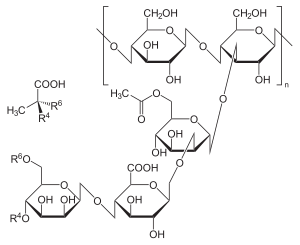Xanthan
 |
|
| Names | |
|---|---|
| Other names
E 415
|
|
| Identifiers | |
| ChemSpider |
|
| ECHA InfoCard | 100.031.255 |
| E number | E415 (thickeners, ...) |
| Properties | |
| C35H49O29 (monomer) | |
| Hazards | |
| R-phrases (outdated) | - |
| S-phrases (outdated) | - |
|
Except where otherwise noted, data are given for materials in their standard state (at 25 °C [77 °F], 100 kPa).
|
|
|
|
|
| Infobox references | |
Xanthan gum (/ˈzænθən/) is a polysaccharide with a wide variety of uses, including as a common food additive. It is a powerful thickening agent, and also has uses as a stabilizer to prevent ingredients from separating.
It can be produced from a range of simple sugars using a fermentation process, and derives its name from the strain of bacteria used in this: Xanthomonas campestris.
Xanthan gum was discovered by Allene Rosalind Jeanes and her research team at the United States Department of Agriculture, and brought into commercial production under the trade name Kelzan in the early 1960s. It was approved for use in foods in 1968 and is accepted as a safe food additive in the USA, Canada, Europe, and many other countries, with E number E415.
Xanthan gum derives its name from the strain of bacteria used during the fermentation process, Xanthomonas campestris. This is the same bacterium responsible for causing black rot to form on broccoli, cauliflower, and other leafy vegetables.
A very small quantity of xanthan gum, 1%, can produce a large increase in the viscosity of a liquid.
In foods, xanthan gum is common in salad dressings and sauces. It helps to prevent oil separation by stabilizing the emulsion, although it is not an emulsifier. Xanthan gum also helps suspend solid particles, such as spices. In frozen foods and beverages, xanthan gum helps create the pleasant texture in many ice creams. Toothpaste often contains xanthan gum, where it serves as a binder to keep the product uniform. Xanthan gum also helps thicken commercial egg substitutes made from egg whites, to replace the fat and emulsifiers found in yolks. It is also a preferred method of thickening liquids for those with swallowing disorders, since it does not change the color or flavor of foods or beverages at typical use levels. In gluten-free baking xanthan gum is used to give the dough or batter the stickiness that would otherwise be achieved with gluten. In most foods, it is used at concentrations of 0.5% or less.
...
Wikipedia
